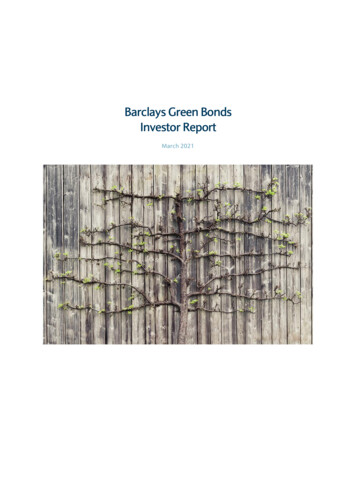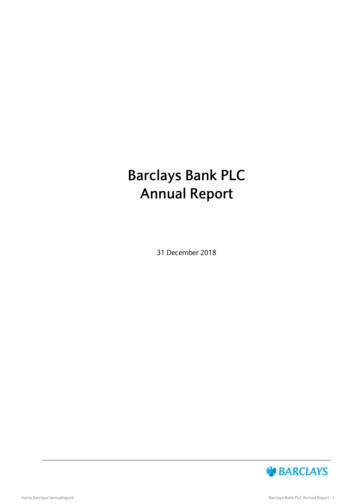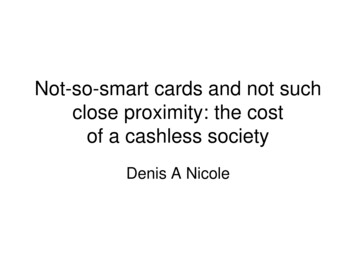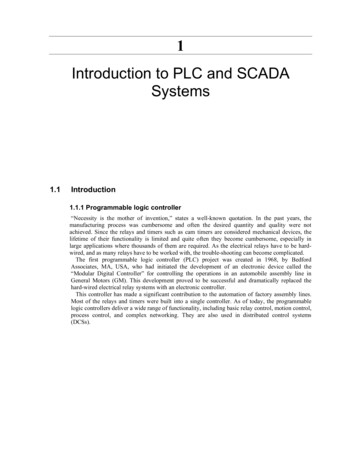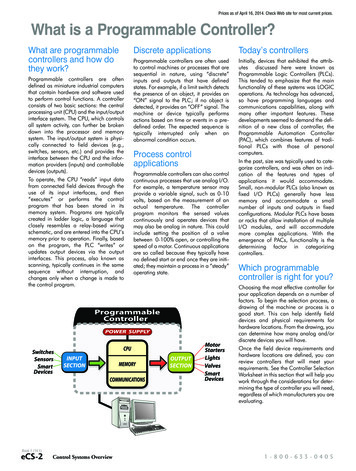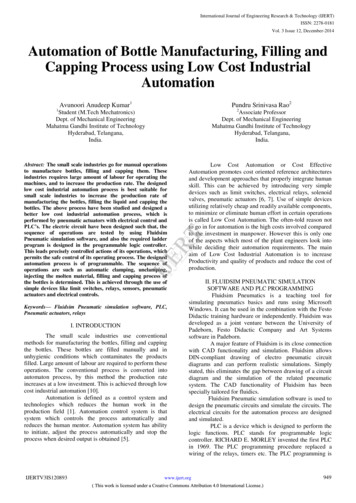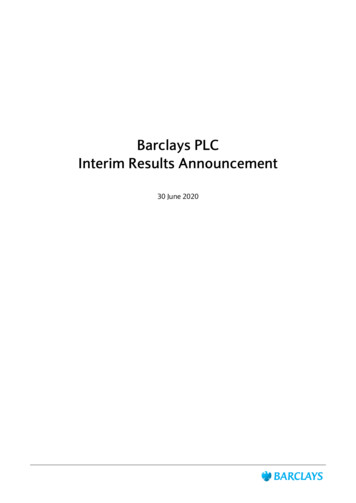
Transcription
Barclays PLCInterim Results Announcement30 June 2020
Table of ContentsResults AnnouncementPageNotes1Performance Highlights2Group Chief Executive Officer’s Review4Group Finance Director’s Review5Results by Business Barclays UK7 Barclays International10 Head Office14Quarterly Results Summary15Quarterly Results by Business16Performance Management Margins and Balances22Risk Management Risk Management and Principal Risks23 Credit Risk25 Market Risk42 Treasury and Capital Risk43Statement of Directors’ Responsibilities55Independent Review Report to Barclays PLC56Condensed Consolidated Financial Statements57Financial Statement Notes63Appendix: Non-IFRS Performance Measures88Shareholder Information98BARCLAYS PLC, 1 CHURCHILL PLACE, LONDON, E14 5HP, UNITED KINGDOM. TELEPHONE: 44 (0) 20 7116 1000. COMPANY NO. 48839.Barclays PLC
NotesThe terms Barclays or Group refer to Barclays PLC together with its subsidiaries. Unless otherwise stated, the income statement analysis compares thesix months ended 30 June 2020 to the corresponding six months of 2019 and balance sheet analysis as at 30 June 2020 with comparatives relating to31 December 2019 and 30 June 2019. The abbreviations ‘ m’ and ‘ bn’ represent millions and thousands of millions of Pounds Sterling respectively;the abbreviations ‘ m’ and ‘ bn’ represent millions and thousands of millions of US Dollars respectively; and the abbreviations ‘ m’ and ‘ bn’ representmillions and thousands of millions of Euros respectively.There are a number of key judgement areas, for example impairment calculations, which are based on models and which are subject to ongoingadjustment and modifications. Reported numbers reflect best estimates and judgements at the given point in time.Relevant terms that are used in this document but are not defined under applicable regulatory guidance or International Financial Reporting Standards(IFRS) are explained in the results glossary that can be accessed at s/latest-financial-results.The information in this announcement, which was approved by the Board of Directors on 28 July 2020, does not comprise statutory accounts withinthe meaning of Section 434 of the Companies Act 2006. Statutory accounts for the year ended 31 December 2019, which contained an unmodifiedaudit report under Section 495 of the Companies Act 2006 (which did not make any statements under Section 498 of the Companies Act 2006) havebeen delivered to the Registrar of Companies in accordance with Section 441 of the Companies Act 2006.These results will be furnished as a Form 6-K to the US Securities and Exchange Commission (SEC) as soon as practicable following their publication.Once furnished with the SEC, a copy of the Form 6-K will be available from the SEC’s website at www.sec.gov.Barclays is a frequent issuer in the debt capital markets and regularly meets with investors via formal road-shows and other ad hoc meetings.Consistent with its usual practice, Barclays expects that from time to time over the coming quarter it will meet with investors globally to discuss theseresults and other matters relating to the Group.Non-IFRS performance measuresBarclays management believes that the non-IFRS performance measures included in this document provide valuable information to the readers of thefinancial statements as they enable the reader to identify a more consistent basis for comparing the businesses’ performance between financial periodsand provide more detail concerning the elements of performance which the managers of these businesses are most directly able to influence or arerelevant for an assessment of the Group. They also reflect an important aspect of the way in which operating targets are defined and performance ismonitored by Barclays management. However, any non-IFRS performance measures in this document are not a substitute for IFRS measures andreaders should consider the IFRS measures as well. Refer to the appendix on pages 88 to 97 for further information and calculations of non-IFRSperformance measures included throughout this document, and the most directly comparable IFRS measures.Forward-looking statementsThis document contains certain forward-looking statements within the meaning of Section 21E of the US Securities Exchange Act of 1934, as amended,and Section 27A of the US Securities Act of 1933, as amended, with respect to the Group. Barclays cautions readers that no forward-looking statementis a guarantee of future performance and that actual results or other financial condition or performance measures could differ materially from thosecontained in the forward-looking statements. These forward-looking statements can be identified by the fact that they do not relate only to historicalor current facts. Forward-looking statements sometimes use words such as ‘may’, ‘will’, ‘seek’, ‘continue’, ‘aim’, ‘anticipate’, ‘target’, ‘projected’,‘expect’, ‘estimate’, ‘intend’, ‘plan’, ‘goal’, ‘believe’, ‘achieve’ or other words of similar meaning. Forward-looking statements can be made in writingbut also may be made verbally by members of the management of the Group (including, without limitation, during management presentations tofinancial analysts) in connection with this document. Examples of forward-looking statements include, among others, statements or guidanceregarding or relating to the Group’s future financial position, income growth, assets, impairment charges, provisions, business strategy, capital,leverage and other regulatory ratios, payment of dividends (including dividend payout ratios and expected payment strategies), projected levels ofgrowth in the banking and financial markets, projected costs or savings, any commitments and targets, estimates of capital expenditures, plans andobjectives for future operations, projected employee numbers, IFRS impacts and other statements that are not historical fact. By their nature, forwardlooking statements involve risk and uncertainty because they relate to future events and circumstances. The forward-looking statements speak onlyas at the date on which they are made and such statements may be affected by changes in legislation, the development of standards andinterpretations under IFRS, including evolving practices with regard to the interpretation and application of accounting and regulatory standards, theoutcome of current and future legal proceedings and regulatory investigations, future levels of conduct provisions, the policies and actions ofgovernmental and regulatory authorities, geopolitical risks and the impact of competition. In addition, factors including (but not limited to) thefollowing may have an effect: capital, leverage and other regulatory rules applicable to past, current and future periods; UK, US, Eurozone and globalmacroeconomic and business conditions; the effects of any volatility in credit markets; market related risks such as changes in interest rates andforeign exchange rates; effects of changes in valuation of credit market exposures; changes in valuation of issued securities; volatility in capital markets;changes in credit ratings of any entity within the Group or any securities issued by such entities; direct and indirect impacts of the coronavirus (COVID19) pandemic; instability as a result of the exit by the UK from the European Union and the disruption that may subsequently result in the UK andglobally; and the success of future acquisitions, disposals and other strategic transactions. A number of these influences and factors are beyond theGroup’s control. As a result, the Group’s actual financial position, future results, dividend payments, capital, leverage or other regulatory ratios or otherfinancial and non-financial metrics or performance measures may differ materially from the statements or guidance set forth in the Group’s forwardlooking statements. Additional risks and factors which may impact the Group’s future financial condition and performance are identified in our filingswith the SEC (including, without limitation, our Annual Report on Form 20-F for the fiscal year ended 31 December 2019 and our 2020 Interim ResultsAnnouncement for the six months ended 30 June 2020 filed on Form 6-K), which are available on the SEC’s website at www.sec.gov.Subject to our obligations under the applicable laws and regulations of any relevant jurisdiction, (including, without limitation, the UK and the US), inrelation to disclosure and ongoing information, we undertake no obligation to update publicly or revise any forward-looking statements, whether asa result of new information, future events or otherwise.Barclays PLC1
Performance HighlightsOpen for business during the COVID-19 pandemic, helping support the economyCOVID-19 supportSupporting customers,business, the community,and our colleagues c.600k payment holidays1 provided to customers, including c.121k in UK mortgages, c.157kin UK credit cards, c.106k in UK personal loans and point of sale finance, and c.216k in UScredit cardsProvided c. 22bn of COVID-19 support for UK businesses, including enabling c. 7.7bn ofgovernment backed Bounce Back Loans1, lending c. 2.5bn under the CBILS programmes1,2and facilitating c. 11.7bn of commercial paper issuance1Helped businesses and institutions to access the global capital markets, including raisingc. 620bn of new issuance in the second quarter 45m of the 100m Community Aid Package distributed to charities and 817 branchesremained open throughout the COVID-19 pandemic, over three-quarters of the branchnetwork70k of 88k colleagues working from homeDiversified business model delivered a resilient operating performance in H120Despite the impacts of the COVID-19 pandemic, Barclays delivered a H120 Group profit before tax of 1.3bn (H119: 3.0bn),resulting in a return on tangible equity (RoTE) of 2.9% (H119: 9.1%) and earnings per share (EPS) of 4.0p (H119: 12.1p). Preprovision profits (profit before tax excluding credit impairment charges) increased 27% to 5.0bn, while credit impairmentcharges increased to 3.7bn (H119: 0.9bn)IncomeStrong CIB income offsettingchallenges in Barclays UKand CC&PGroup income of 11.6bn up 8% versus prior year Corporate and Investment Bank (CIB) income of 6.9bn up 31% versus prior year drivenby a standout performance in Markets Consumer, Cards and Payments (CC&P) income of 1.7bn down 21% versus prior yearprimarily due to lower balances and consumer spending volumes Barclays UK income of 3.2bn down 11% versus prior year reflecting lower interest ratesand UK cards balances, COVID-19 customer support actions and the removal of certain feesCostsGroup total operating expenses of 6.6bn down 4% versus prior yearImproved cost: income ratio Credit impairment chargesCredit impairment charges increased to 3.7bn (H119: 0.9bn), including 1.6bn in Q220Increased impairmentprovisioning driving highercoverage ratios acrossportfoliosCapital, liquidity and TNAVStrong capital and liquiditypositionCost efficiencies and cost discipline contributed to positive cost: income jaws of 12%resulting in an improved cost: income ratio of 57% (H119: 64%) The charge reflects 0.6bn in respect of single name wholesale loan charges in the periodand 2.4bn impact from revised IFRS 9 scenarios Impairment coverage ratio for the unsecured consumer lending portfolio increased to 12.0%(FY19: 8.1%). Coverage for exposures to selected industry sectors regarded as particularlyvulnerable to the COVID-19 pandemic increased to 4.0% (FY19: 2.3%)Common equity tier 1 (CET1) ratio of 14.2% (December 2019: 13.8%) The increase over the first half of the year reflects profits, regulatory measures andcancellation of the full year 2019 dividend payment, partially offset by higher Risk WeightedAssets (RWAs) Headroom of 3.0% above revised Maximum Distributable Amount (MDA) hurdle, which hasreduced to 11.2%3 Tangible net asset value (TNAV) per share increased to 284p (December 2019: 262p) Income in Barclays UK and CC&P is expected to gradually recover from Q220 levels, butcertain headwinds, including from the low interest rate environment, are likely to persist into2021After a strong performance in H120 the CIB franchise is well positioned for the futureImpairment in H220 is expected to remain above the level experienced in recent years, but tobe below the H120 impairment charge assuming no change in macroeconomic forecastsContinued focus on cost discipline, but short-term headwinds remain from spend on COVID19 initiativesIn H220 there may be headwinds to the CET1 ratio from procyclical effects on RWAs, andreduced benefit from transitional relief on IFRS 9 impairmentThe Board will decide on future dividends and its capital returns policy at FY20Group outlookGroup outlookGiven the uncertaineconomic outlook and lowinterest rate environment,the second half of the year isexpected to continue to bechallenging 123Payment holiday data as at 22 July 2020. Business lending and commercial paper issuance data as at 27 July 2020.The Coronavirus Business Interruption Loan Scheme (CBILS) and the Coronavirus Large Business Interruption Loan Scheme programmes (together the CBILS programmes).Barclays’ MDA hurdle reduced to 11.2% in July 2020, and will fluctuate through the cycle given recent regulatory changes.Barclays PLC2
Performance HighlightsBarclays Group resultsfor the half year endedTotal incomeCredit impairment chargesNet operating incomeOperating expensesLitigation and conductTotal operating expensesOther net (expenses)/income30.06.20 m11,62130.06.19 m10,790(3,738)(928)% 593)(6,872)4(18)24Profit before tax1,2723,014Tax charge(113)(545)79Profit after tax1,1592,469(53)Non-controlling interestsOther equity instrument holdersAttributable %9.1%Performance measuresReturn on average tangible shareholders' equityAverage tangible shareholders' equity ( bn)48.645.7Cost: income ratio57%64%Loan loss rate (bps)20754Basic earnings per share4.0p12.1p-3.0p1,3023,128(58)(67)Dividend per sharePerformance measures excluding litigation and conduct1Profit before taxAttributable profit7102,158Return on average tangible shareholders' equity2.9%9.4%Cost: income ratio56%63%Basic earnings per share4.1p12.6pAs at 30.06.20As at 31.12.19As at 30.06.19 bn284p bn262p bn275p14.2%13.8%13.4%45.440.842.9Risk weighted assets319.0295.1319.1Average UK leverage ratio4.7%4.5%4.7%UK leverage ratio5.2%5.1%5.1%Balance sheet and capital management2Tangible net asset value per shareCommon equity tier 1 ratioCommon equity tier 1 capitalFunding and liquidityGroup liquidity pool ( bn)Liquidity coverage ratioLoan: deposit ratio12298211238186%160%156%76%82%82%Refer to pages 88 to 97 for further information and calculations of performance measures excluding litigation and conduct.Refer to pages 48 to 53 for further information on how capital, RWAs and leverage are calculated.Barclays PLC3
Group Chief Executive Officer’s Review“This has been a period focussed on supporting our customers, clients and the UK economy through the COVID-19 pandemic– providing the people and businesses that we serve with a bridge to recovery in every way we can.Since late March, we have helped to deliver around 22bn of vitally important COVID-19 government support measures toUK businesses to help fund them, including c.250k government backed Bounce Back Loans totalling c. 7.7bn, c. 2.5bn underthe CBILS programmes and c. 11.7bn of commercial paper issuance.1To help consumers with their short-term household finances more than 600k payment holidays1 have been provided alongwith other fee waivers and support measures. We have also already distributed 45m of our 100m Community Aid Packageto COVID-19 related charities in the UK, US and India to help rebuild communities.Our CIB is taking a leading role helping clients to access capital markets to raise equity and debt, underwriting c. 620bn ofnew issuance in the quarter. In the equity capital markets, where we are a UK leader and broker to 40 of the FTSE 100 andFTSE 250 companies, we supported UK companies to raise 4.0bn as they navigate this crisis.I remain very proud of the dedication and diligence of our 88k colleagues who have been working extremely hard to help ourclients and customers through these tough times, playing our full part in the recovery efforts and delivering support at scale.The reason that we have been able to support the economy as extensively as we have and remain financially resilient isbecause of our diversified universal banking model. Our strength in diversification has delivered pre-provision profits of 5.0bnand, even after impairment, we remain profitable. Income increased 8% to 11.6bn for the half, with total costs down 4% to 6.6bn resulting in positive jaws of 12%, and an improved cost to income ratio of 57% versus prior year.In our CIB, income increased 31% to 6.9bn driven by strong performance in our Markets business, particularly in FICC (up83%) and Equities (up 26%), and an 8% increase in Banking fees income through continued momentum in both debt andequity capital markets.Our consumer business income decreased by 11% in Barclays UK and 21% in CC&P as a result of the lower interest rateenvironment, fewer interest earning balances, reduced payments activity and action to provide support for customers.Credit impairment charges increased to 3.7bn in the first half due to the forecast impact of COVID-19. However, our improvedpre-impairment performance ensured that we still delivered 1.3bn profit before tax for the first half of 2020, post impairment.In the quarter Group total income decreased 4% year-on-year to 5.3bn, with total costs down 6% to 3.3bn. Following our 1.6bn quarterly credit impairment charge, profit before tax was 359m, and Group RoTE was 0.7%, with EPS of 0.5p.Our CET1 ratio stands at 14.2% which underscores the strength of our balance sheet. Although we will remain well capitalisedand ahead of our minimum requirements, we may experience stronger capital headwinds in the second half of the year. TheBoard will decide on future dividends and capital returns at the year-end 2020.While the remainder of 2020 will be challenging, our diversified model means we can remain financially resilient and continueto support our customers and clients.”James E Staley, Group Chief Executive Officer1Payment holiday data as at 22 July 2020. Business lending and commercial paper issuance data as at 27 July 2020.Barclays PLC4
Group Finance Director’s ReviewGroup performance Statutory RoTE was 2.9% (H119: 9.1%) and statutory EPS was 4.0p (H119: 12.1p) Profit before tax was 1,272m (H119: 3,014m). Excluding litigation and conduct, profit before tax was 1,302m (H119: 3,128m), as positive operating leverage from an 8% increase in income and 3% reduction in operating expenses wasoffset by materially higher credit impairment charges Pre-provision profits increased 27% to 5,010m, benefitting from the Group’s diversified business model, as strongperformance in CIB more than offset income headwinds in Barclays UK and CC&P Total income increased 8% to 11,621m. Barclays UK income decreased 11% due to ongoing margin pressure, includingCOVID-19 customer support actions, base rate reductions, lower UK cards interest earning lending (IEL) and overdraftbalances, as well as lower income due to the removal of certain fees in overdrafts and UK cards. Barclays Internationalincome increased 16%, with CIB income up 31% and CC&P income down 21%. Within CIB, Markets income increaseddue to a strong performance across FICC and Equities. Banking fees income increased reflecting a strong performance indebt and equity capital markets, while there was a reduction in Corporate income driven by fair value losses, margincompression and carry costs on hedges. CC&P income decreased primarily as a result of lower balances on co-brandedcards and a c. 100m valuation loss on Barclays’ preference shares in Visa Inc. Credit impairment charges increased to 3,738m (H119: 928m). This increase primarily reflects 591m in respect ofsingle name wholesale loan charges and 2.4bn impact from revised IFRS 9 scenarios (the “COVID-19 scenarios”)reflecting forecast deterioration in macroeconomic variables (including a prolonged period of heightened UK and USunemployment), partially offset by the estimated impact of central bank, government and other support measures Operating expenses decreased 3% to 6,563m reflecting cost efficiencies and continued cost discipline in the currentenvironment. The Group delivered positive cost: income jaws of 11% which resulted in the Group cost: income ratio,excluding litigation and conduct, reducing to 56% (H119: 63%). The Group accrued compensation costs reflective ofbusiness performance, resulting in a compensation: income ratio of 32.2% (H119: 34.4%) The effective tax rate was 8.9% (H119: 18.1%). This reflects the tax benefit recognised for a re-measurement of UKdeferred tax assets as a result of the UK corporation tax rate being maintained at 19%. The Group’s effective tax rate forthe full year is expected to be around 20%, excluding litigation and conduct Attributable profit was 695m (H119: 2,072m). Excluding litigation and conduct, attributable profit was 710m (H119: 2,158m), generating a RoTE of 2.9% (H119: 9.4%) and EPS of 4.1p (H119: 12.6p) Total assets increased to 1,385bn (December 2019: 1,140bn), primarily due to a 78bn increase in derivative assets(with a corresponding increase in derivative liabilities), 52bn increase in cash collateral and settlement balances, and 26bn increase in financial assets at fair value through the income statement. The low interest rate environment hasresulted in significant decreases in forward interest rate curves which coupled with increased client activity and theappreciation of period end USD against GBP has resulted in rising asset values. Loans and advances have also increasedby 16bn, which reflects the 7.1bn of lending under the government backed Bounce Back Loan Scheme (BBLS) and theCBILS which Barclays UK has provided to support businesses through the COVID-19 pandemic TNAV per share increased to 284p (December 2019: 262p) reflecting 4.0p of statutory EPS and positive reservemovements, including retirement benefit re-measurements and currency translation reservesGroup capital and leverage The CET1 ratio increased to 14.2% (December 2019: 13.8%)–CET1 capital increased by 4.6bn to 45.4bn reflecting resilient capital generation through 4.9bn of profits after tax,excluding credit impairment charges and a 1.0bn increase due to the cancellation of the full year 2019 dividend–Impairment charges of 3.7bn before tax were partially offset by a 1.3bn increase in IFRS 9 transitional relief aftertax, which was driven by 1.2bn in Q220 due to both the new impairment charges and the implementation of newregulatory measures which allow for 100% relief on increases in stage 1 and stage 2 impairment throughout 2020and 2021–RWAs increased by 23.9bn to 319.0bn primarily due to higher market volatility and client activity within CIB as wellas a reduction in credit quality, partially offset by lower CC&P balances The average UK leverage ratio increased to 4.7% (December 2019: 4.5%) primarily driven by the increase in CET1 capital.The average leverage exposure increased to 1,149bn (December 2019: 1,143bn) The UK leverage ratio increased to 5.2% (December 2019: 5.1%) primarily driven by the increase in CET1 capital, partiallyoffset by an increase in leverage exposure. The leverage exposure increased by 63bn to 1,071bn, primarily driven by anincrease in IFRS total assets, partially offset by the Prudential Regulation Authority’s (PRA) early adoption of CRR IIsettlement nettingBarclays PLC5
Group Finance Director’s ReviewGroup funding and liquidity The liquidity pool was 298bn (December 2019: 211bn) and the liquidity coverage ratio (LCR) remained significantlyabove the 100% regulatory requirement at 186% (December 2019: 160%), equivalent to a surplus of 135bn (December2019: 78bn). The increase in the liquidity pool, LCR and surplus is driven by a 12% growth in customer deposits andactions to maintain a prudent funding and liquidity position in the current environment Wholesale funding outstanding, excluding repurchase agreements, was 181.9bn (December 2019: 147.1bn). TheGroup issued 4.8bn equivalent of minimum requirement for own funds and eligible liabilities (MREL) instruments fromBarclays PLC (the Parent company) during the year. The Group is well advanced in its MREL issuance plans, with a BarclaysPLC MREL ratio of 32.4% as at 30 June 2020 (December 2019: 31.2%) relative to an estimated requirement (includingrequisite buffers) of c.29.7% by 1 January 2022Other matters As at 30 June 2020, the Group held a provision of 774m relating to Payment Protection Insurance (PPI). Since theprovision increase in 2019, 70% of the items outstanding as at 30 September 2019 have been resolved (including invaliditems) and observations from these resolved complaints continue to support the provision levelDividends and capital returns In response to a request from the PRA, and to preserve additional capital for use in serving Barclays customers and clientsthrough the extraordinary challenges presented by the COVID-19 pandemic, the Board agreed to cancel the 6.0p perordinary share full year 2019 dividend. The Board also decided that for 2020 Barclays would suspend its current capitalreturns policy and accordingly will not undertake any interim ordinary share dividend payments, regulatory accruals ofordinary share dividends, or share buybacks. The Board will decide on future dividends and its capital returns policy atyear-end 2020Outlook and guidance Given the uncertain economic outlook and low interest rate environment, the second half of the year is expected tocontinue to be challenging–Income in Barclays UK and CC&P is expected to gradually recover from Q220 levels, but certain headwinds includingfrom the low interest rate environment, are likely to persist into 2021–The CIB performance in the first half benefitted from increased issuance activity and trading volumes, with thefranchise well positioned for the future–Impairment in H220 is expected to remain above the level experienced in recent years, but to be below the H120 creditimpairment charge assuming no change in macroeconomic forecasts Continued focus on cost discipline, but short-term headwinds remain from spend on COVID-19 initiatives In H220 there may be headwinds to the Group’s CET1 ratio from procyclical effects on RWAs, and reduced benefit fromtransitional relief on IFRS 9 impairment. However, the Group’s CET1 ratio will continue to be managed to maintain anappropriate headroom above the MDA hurdle The Group continues to target a RoTE1 of 10% and cost: income ratio of 60% over time, but targets remain subject tochange depending on the evolution of the COVID-19 pandemicTushar Morzaria, Group Finance Director1Excluding litigation and conduct.Barclays PLC6
Results by BusinessBarclays UKIncome statement informationNet interest incomeNet fee, commission and other incomeTotal incomeCredit impairment chargesHalf year endedHalf year ended30.06.2030.06.19 m2,637 m2,907% 1Other net incomeProfit before tax13-681,062(94)Attributable profit52750(93)As at 30.06.20As at 31.12.19As at 30.06.19Loans and advances to customers at amortised cost bn202.0 bn193.7 bn189.1Total assets287.6257.8259.0Customer deposits at amortised cost225.7205.5200.9Loan: deposit ratio92%96%97%Risk weighted assets77.974.976.2Period end allocated tangible equity10.310.310.3Half year endedHalf year ended30.06.2052%30.06.1950%68%67%Net operating incomeOperating expensesLitigation and conductTotal operating expensesBalance sheet informationKey factsAverage loan to value of mortgage portfolio1Average loan to value of new mortgage lending1Number of branches904972Mobile banking active customers8.7m7.9m30 day arrears rate - Barclaycard Consumer UK2.0%1.8%1.0%14.5%Performance measuresReturn on average allocated tangible equityAverage allocated tangible equity ( bn)10.210.3Cost: income ratio65%58%Loan loss rate (bps)10143Net interest margin2.69%3.11% m79 m1,106% Change(93)60782(92)Return on average allocated tangible equity1.2%15.1%Cost: income ratio64%57%Performance measures excluding litigation and conduct2Profit before taxAttributable profit12Average loan to value of mortgages is balance weighted and reflects both residential and buy-to-let (BTL) mortgage portfolios within the Home Loansportfolio.Refer to pages 88 to 97 for further information and calculations of performance measures excluding litigation and conduct.Barclays PLC7
Results by BusinessAnalysis of Barclays UKHalf year endedHalf year ended30.06.2030.06.19 m1,794 m1,910% Change(6)Barclaycard Consumer UK803987(19)Business Banking574651(12)3,1713,548(11)Analysis of total incomePersonal BankingTotal incomeAnalysis of credit impairment chargesPersonal Banking(264)(88)Barclaycard Consumer UK(697)(315)Business Banking(103)(18)(1,064)(421)As at 30.06.20As at 31.12.19As at 30.06.19 bn154.9 bn151.9 bn147.3Barclaycard Consumer UK11.514.715.1Business .1--56.046.344.6225.7205.5200.9Total credit impairment chargesAnalysis of loans and advances to customers at amortised costPersonal BankingTotal loans and advances to customers at amortised costAnalysis of customer deposits at amortised costPersonal BankingBarclaycard Consumer UKBusiness BankingTotal customer deposits at amortised costBarclays PLC8
Results by BusinessBarclays UK continued to support customers during H120, increasing lending by 8.3bn, predominantly through 7.1bn ofBBLS and CBILS. Customer deposits grew by 20.2bn, reflecting the
Notes Barclays PLC 1 The terms Barclays or Group refer to Barclays PLC together with its subsidiaries. Unless otherwise stated, the income statement analysis compares the

